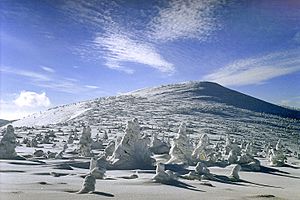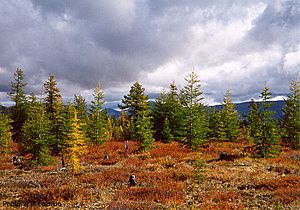Tree line facts for kids
The tree-line (or timberline) is the highest or farthest point where trees can grow. Beyond this line, conditions are too harsh for trees to survive. Think of it as an invisible border where the forest stops.
There are different types of tree-lines, each caused by different things:
- Arctic tree-line: This is the most northern place in the world where trees can grow. Go any farther north, and it's simply too cold for them.
- Antarctic tree-line: Similar to the Arctic, this is the most southern place where trees can grow. It's also too cold beyond this line.
- Alpine tree-line: This is the highest point on a mountain where trees can grow. Higher up, it gets too cold, or snow covers the ground for too much of the year. The weather above this line is called an alpine climate.
- Exposure tree-line: On coasts or lonely mountains, the tree-line can be much lower than in other places. This happens because strong winds make it hard for trees to grow tall.
- Desert tree-line: In deserts, trees can't grow because there isn't enough rainfall.
- Toxic tree-line: Sometimes, the ground itself is too dangerous for trees. This can be due to hot lava, steam, acid, or too much salt in the soil. It can also be caused by pollution from humans.
- Wetland tree-line: This is found near very wet areas like bogs. The ground is so full of water that tree roots can't get enough oxygen to grow. However, some trees, like mangroves, are special and can grow in waterlogged soil.

At the tree-line, trees often look like low bushes instead of tall trees. If strong winds cause this, these twisted, stunted trees are called krummholz. This German word means 'twisted wood'.
From far away, a tree-line looks like a clear, sharp line. But if you get closer, you'll see that trees just gradually get shorter and shorter until they stop growing completely.
Contents
Trees You Find at Tree-lines
Many trees that grow at tree-lines are conifers (trees with needles and cones). Here are some examples:
- Dahurian Larch (Larix gmelinii)
- Foxtail Pine (Pinus balfouriana)
- Great Basin Bristlecone Pine (Pinus longaeva)
- Rocky Mountains Bristlecone Pine (Pinus aristata)
- Potosi Pinyon (Pinus culminicola)
- Macedonian Pine (Pinus peuce)
- Whitebark Pine (Pinus albicaulis)
- Swiss Pine (Pinus cembra)
- Mountain Pine (Pinus mugo)
- Hartweg's Pine (Pinus hartwegii)
- Subalpine Larch (Larix lyallii)
- Arctic White Birch (Betula pubescens subsp. tortuosa)
- Snow Gum (Eucalyptus pauciflora)
- Antarctic Beech (Nothofagus Antarctica)
Alpine Tree-lines Around the World
The exact height of an alpine tree-line changes depending on where it is. Things like the direction a mountain slope faces, whether it's in a rain shadow (a dry area behind a mountain), and how close it is to the geographical pole all play a part.
Here's a table showing the average height of tree-lines in different places around the world:
| Location | Approx. latitude | Approx. elevation of tree-line | Notes | |
|---|---|---|---|---|
| (m) | (ft) | |||
| Sweden | 68°N | 800 | 2600 | |
| Norway | 61°N | 1100 | 3600 | Lower near the coast |
| Swiss Alps | 46°N | 2100 | 6900 | Higher on the southern side of the Alps. |
| New Hampshire, USA | 44°N | 1220 | 4000 | Some peaks have lower tree-lines because of past fires and soil loss. |
| Wyoming, USA | 43°N | 3000 | 9800 | |
| Rocky Mountain NP, USA | 40°N | 3500 | 11500 | On warm southwest slopes; lower (about 2400 m or 8000 ft) on northeast slopes |
| Japanese Alps | 39°N | 2900 | 9500 | |
| Yosemite, USA | 38°N | 3200 | 10500 | West side of Sierra Nevada |
| Yosemite, USA | 38°N | 3600 | 11800 | East side of Sierra Nevada |
| Himalaya | 28°N | 4400 | 14400 | |
| Hawaii, USA | 20°N | 2800 | 9000 | Not much rain above the trade winds |
| Costa Rica | 9.5°N | 3400 | 11200 | |
| Mount Kilimanjaro, Tanzania | 3°S | 3000 | 9800 | |
| New Guinea | 6°S | 3900 | 12800 | |
| Andes, Peru | 11°S | 3900 | 12800 | East side; on the west side, trees struggle due to dryness. |
| Sierra de Córdoba, Argentina | 31°S | 2000 | 6560 | Not much rain above trade winds, also very windy. |
| Australian Alps, Australia | 36°S | 2000 | 6560 | West side of Australian Alps |
| Australian Alps, Australia | 36°S | 1700 | 5580 | East side of Australian Alps |
| South Island, New Zealand | 43°S | 1200 | 3940 | The strong ocean influence makes summers cool, which limits tree growth. |
Arctic and Antarctic Tree-lines
Just like alpine tree-lines, the tree-lines near the North and South Poles are affected by local conditions. For example, trees can often grow in river valleys farther north than they could on an open, windy hillside. Ocean currents also play a big role in how far from the equator trees can grow.
Here are some typical polar tree-lines:
| Location | Approx. longitude | Approx. latitude of tree-line | Notes |
|---|---|---|---|
| Norway | 24°Q | 71°N | The North Atlantic current makes the Arctic climate here warmer than other coastal places at the same latitude. |
| West Siberian Plain | 75°R | 66°N | |
| Central Siberian Plateau | 102°S | 72°N | The extreme continental climate means summers are warm enough for trees to grow at very high latitudes, reaching 72°30'N in the Novaya River valley. |
| Russian Far East (Kamchatka and Chukotka) | 160°E | 60°N | The Oyashio Current and strong winds keep summer temperatures low, stopping trees from growing. The Aleutian Islands have almost no trees. |
| Alaska | 152°W | 68°N | Trees grow north on the south-facing slopes of the Brooks Range. The mountains block cold air from the Arctic Ocean. |
| Northwest Territories, Canada | 132°W | 69°N | Reaches north of the Arctic Circle because of the continental climate and warmer summer temperatures. |
| Nunavut | 95°W | 61°N | The very cold Hudson Bay pushes the tree-line southward. |
| Quebec | 72°W | 56°N | The Labrador Current has a very strong effect on summer temperatures. In parts of Labrador, the tree-line goes as far south as 53°N. |
| Greenland | 50°W | 64°N | There are no native trees here because it's so isolated. A few experimental trees are surviving, but growing slowly, at Søndre Strømfjord, 67°N. |
| Tierra del Fuego, Chile and Argentina | 69°W | 55°S | Trees grow very close to the southernmost tip of South America. The limit here is more about extreme winds than the climate. |
Images for kids
-
An alpine tree-line in the Tararua Range
-
A tree-line of conifer trees below Vihren Peak, Pirin Mountain, Bulgaria
-
A view of a Magellanic lenga forest near the tree-line in Torres del Paine National Park, Chile
See also
 In Spanish: Límite del bosque para niños
In Spanish: Límite del bosque para niños






